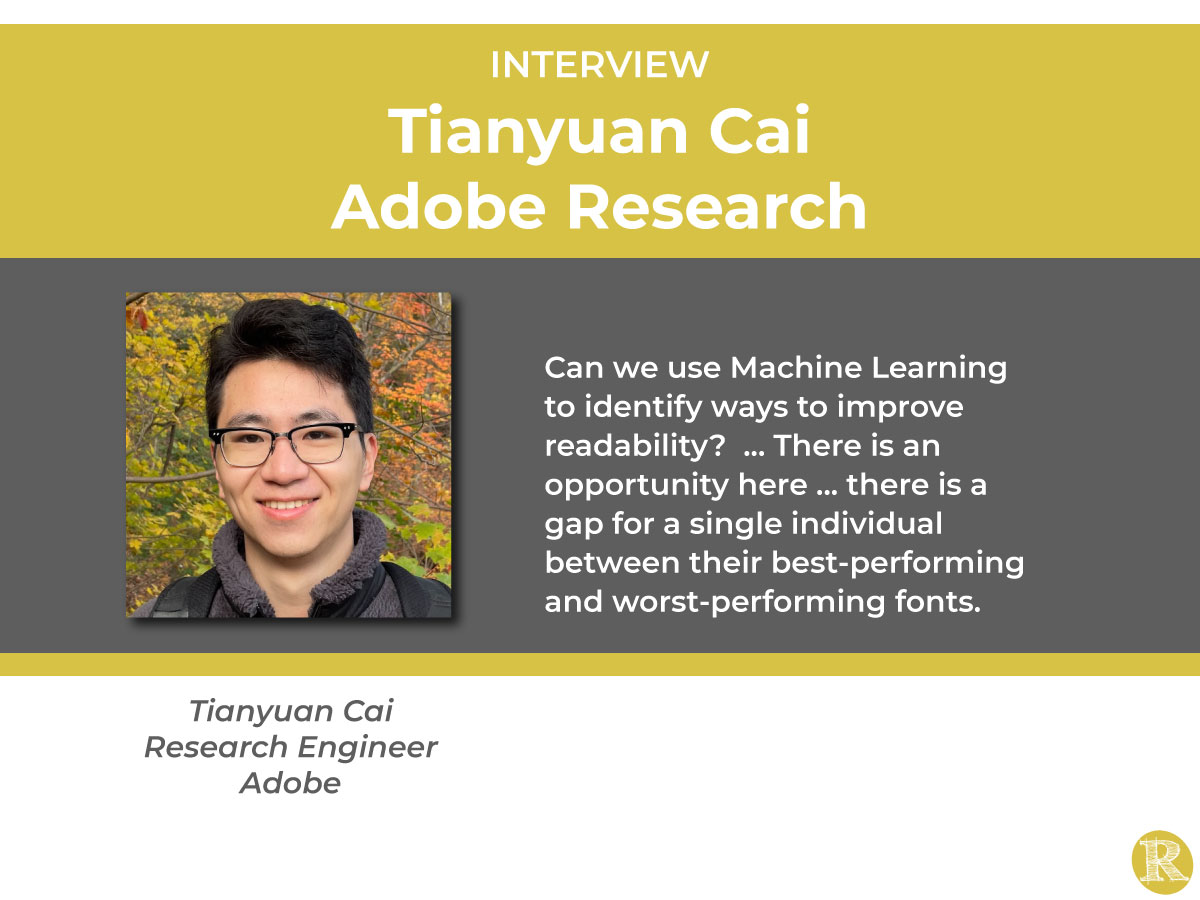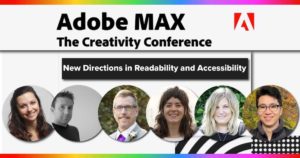Passion for Readability Work Leads ML Engineer to Adobe Research
Readability Matters sat down with Tianyuan (Tian) Cai to discuss how his multidisciplinary experience led him to his position as a research engineer with Adobe Research. Tian is a problem-solver who uses his technical expertise and innovative thinking to create solutions for society’s complex challenges. He cares deeply about solving real-world problems and improving user experiences.
Tian’s background includes economics, statistics, and media studies. During his last year of college, he started doing more project work applying statistics and machine learning to real-world problems. After working in economic research, he joined Adobe as a Machine Learning Engineer.
Tian has been part of the readability research community for several years. His research focuses on leveraging human-computer interaction to improve the designs of digital content. He takes an interdisciplinary approach to research, with toolkits spanning crowdsourcing, prototyping, and perceptual user studies.
Last year, Tian joined Adobe Research as a research engineer. His readability research contributions include several publications. He was the principal investigator of research published at the ACM SIGCHI Conference on Designing Interactive Systems. He developed “FontMART” to deliver personalized font recommendations using machine learning. Tian’s latest research on reading themes will be presented next week (April 25, 2023) at CHI 2023 in Hamburg, Germany. (Learn more: https://dl.acm.org/doi/10.1145/3544549.3585679)
We talked to Tian about his work in Adobe Research. His goal is to help create new research models to accelerate the engineering and deployment of readability solutions to improve readability for all.
RM: Tell me more about your interest in readability research. As I understand it, this was not your first job at Adobe; you started working on readability projects off-hours on nights and weekends.
Tian: After moving to the Adobe Boston/Newton offices, I worked on the [Adobe Acrobat] Liquid Mode program. It was the early days, and there were questions about how changes in text format may help people read more comfortably.
I regularly had lunch with Rick Treitman, who spearheaded Adobe’s readability initiative. He introduced me to Zoya Bylinskii, who led the readability research for Adobe.
Rick, Zoya, and the product management team had questions about who used Liquid Mode and how they adjusted the Reading Settings. I analyzed the user behavioral data to see if I could find interesting patterns. And the more I worked with the Readability teams, the more I became interested in the work.
RM: What inspired you to move to Adobe Research?
Tian: I have always been interested in research. The summer after my first year of college, I received a fellowship to research documentary photography in South Africa. When answering a challenging question, research helps evaluate possibilities, reveal connections between solutions, or develop new approaches. It resonates with my interest in discovering patterns in data. The quantitative aspect of using machine learning to capture varied individual experiences and distill them into patterns made a big impact on me.
Over the two years I’ve spent on readability research, I realized that it’s a really interesting field with much potential. It’s an emerging field, and I’m excited to be a part of it. And, Adobe Research is the perfect place to pursue my interest because of the freedom and support it offers.
RM: Can you tell me about your FontMART project and where you see the research going?
Tian: Digital reading interface provides myriads of controls over text formatting, and we wondered if there are some early recommendations, some low-hanging fruit, as the extensive research continues. Through experiments, we found quantitative and qualitative evidence that helping people select fonts makes a big difference.
There are many other factors that might influence readability recommendations. Does a reader’s background, culture, age, digital interfaces, speaking a different language, and so on provide insights? There is an opportunity here because there is a gap for a single individual between their best-performing and worst-performing format.
RM: Looking to the future, what are the possibilities for readability? What would you say is the potential impact of the readability community’s work?
Tian: Honestly, I don’t think I was fully aware of the scale of the reading problem. Research has already demonstrated that changes to text can create significant reading improvements.
The format we read in is often controlled by designers and publishers of the content. But it doesn’t have to be the case. We can understand and explore new ways to improve digital interfaces for everyone. This can support those who struggle with reading every day, average readers, and even the most proficient readers.
RM: Tell me something about you that most of us don’t know.
Tian: I really like statistics. Statistics is the coolest thing ever.
 About Tianyuan Cai: Tianyuan Cai is a research engineer at Adobe Research. His research focuses on leveraging Human-AI collaborations to improve the user experience when consuming digital content. He tackles these challenges with ML-supported interface adaptation and information visualizations. Tian takes an interdisciplinary approach to research, with toolkits spanning crowdsourcing, prototyping, machine learning, and perceptual user studies. Learn more at Tian’s website, Adobe Research, Twitter @_tcai , and LinkedIn.
About Tianyuan Cai: Tianyuan Cai is a research engineer at Adobe Research. His research focuses on leveraging Human-AI collaborations to improve the user experience when consuming digital content. He tackles these challenges with ML-supported interface adaptation and information visualizations. Tian takes an interdisciplinary approach to research, with toolkits spanning crowdsourcing, prototyping, machine learning, and perceptual user studies. Learn more at Tian’s website, Adobe Research, Twitter @_tcai , and LinkedIn.





